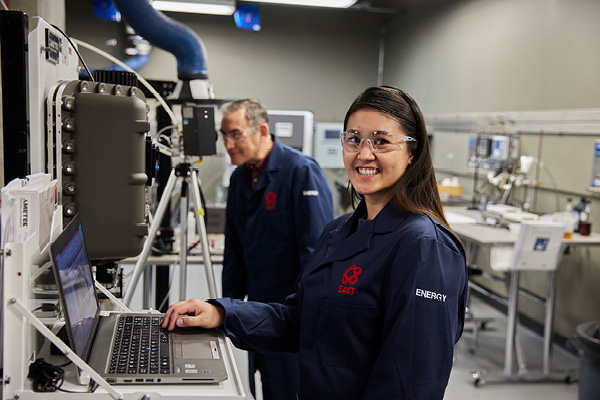On this page:
Overview
Get hands-on in our two-year electrical trades technology diploma and take advantage of this unique pathway into an apprenticeship.
You'll be taught by industry-trained instructors who combine theory and hands-on learning opportunities so you develop the in-demand knowledge, skills and practical experience needed to excel as a professional electrician in Canada's dynamic construction industry.
In this program, you will:
- gain comprehensive knowledge and understanding of electrical theory and its application to lighting, power and control equipment
- layout various electrical circuits in residential, commercial, industrial and institutional complexes and buildings.
- implement the instructions given in plans and specifications pertaining to electrical installations
- become familiar with the safety requirements for electrical installations
- learn to troubleshoot and maintain electrical systems and equipment
- use the test instruments and tools necessary to perform tasks
- become familiar with the work of other tradespeople in the construction industry and the different types of building construction.
This program will prepare you to work as an electrician, fire alarm technician, electrical contractor, foreman, project manager or estimator, parts person, sales and account representative or renewable energy installer.
If you are after an in-demand career with high wages, enjoy working with your hands and find excitement in a constantly evolving industry, this program is for you.
After completing this program, you will have the opportunity to complete the on-the-job training component of an apprenticeship to receive a journeyperson's certificate and pursue your Red-Seal certification.
Those working in electrical trades and technology tend to be objective, innovative and methodical.
You need:
- a willingness to experiment, improvise, innovate, and imagine
- an aptitude for math
- to analyze, evaluate, synthesize, and reconstruct information to inform and make logical and reasoned decisions and judgements
- physical strength and stamina
- to understand and facilitate the connection between people, society and the planet for the sustainability of systems, both cultural and environmental
- to seek out information and experiences and strive to understand
- to work and communicate effectively with others.
Those who find employment working in homes or businesses should be prepared to maintain a neat appearance and be comfortable dealing with customers.
This program aligns with the Alberta Apprenticeship and Industry Training (AIT) curriculum for electricians. If you are in good standing at the end of each semester, you can challenge the AIT exam relevant to that semester.
Graduates of the program are eligible to write both the Construction Electrician Red-Seal exam and the Industrial Electrician Red-Seal exam. Upon passing, you can register as an apprentice and complete the on-the-job training hours to earn your journeyperson designation.
After completing the second semester of this program, you will have the option to participate in a work-integrated learning co-op and gain work experience hours that can be used towards your apprenticeship.
Electrical contractors and fire safety organizations require highly trained individuals to install, maintain, and inspect fire alarm systems.
Graduates of this program will have completed the technical training requirements for Canadian Fire Alarm (CFAA) technicians and be eligible to challenge the final written and practical exams to earn their certification.
After successfully completing this program, you'll receive a SAIT Electrical Trade and Technology diploma.
Careers and opportunities
Our graduates may work in the following occupations. Some careers require additional experience and education.

Career planning support
Unsure which career path is for you? Here are some recommended career planning resources to help you decide your future.
You can also head to Alberta alis for lots of information about careers in Alberta, including quizzes and labour market information to help you narrow down a path.
Finally, you can take our online career finder quiz, which can help narrow your options based on your current skills and interests.
Courses
The Electrical Trade and Technology Diploma requires 66 credits (21 courses) to complete.
The program spans two years, with two to three semesters in the first year (depending on if you choose to complete the optional work term) and two semesters in the second year.
View classes by semesterYou must take all of the following courses to complete this program.
| Course | Credits |
|---|---|
|
This course provides an introduction and general understanding of fire alarm detection and protection systems. You'll begin by examining hazards, procedures and equipment related to fire protection, as well as identifying and describing fire detection and alarm system regulations. You'll determine the criteria for the installation of a fire alarm system and for the location of its components, which includes interpreting drawings and specifications. You'll then get hands-on practice connecting, testing and troubleshooting fire alarm systems. You'll conclude the course by learning how to verify and maintain fire alarm systems. |
1.5 |
|
Building on previous course material, this advanced course in fire alarm detection systems examines in greater detail the applications of fire alarm systems, as well as their operation, testing and inspection requirements. You'll also explore the principles and technology of fire detection devices, signal appliances, control equipment and ancillary devices controlled by the system. The course also covers traditional field wiring circuits, the connection of field devices, and the basics of microprocessor-based systems using addressable devices and remote annunciation. Other life safety support systems, such as smoke control and elevator recall, are also covered. Pre-requisites:
|
1.5 |
|
This course is designed to develop technical writing and presentation skills to ensure workplace readiness. Students will learn how to evaluate communication situations, analyze documents, assess research sources and develop organizational skills to apply in their work. They will learn about and practice designing, formatting and writing a range of professional documents. Students will also develop confidence (through practice) in the development and delivery of effective and engaging presentations. Equivalents:
|
3 |
|
This applied computer course provides students with critical electronic communications, data and file management skills, along with a strong focus on using common productivity applications to format, calculate, analyze, visualize, and present or report data and information. Industry standard project management principles are implemented throughout the course from a digital perspective, so students can have an appreciation for how computing skills relate to real world business processes. |
3 |
|
In this course, you'll be introduced to key concepts in electrical theory, including circuit fundamentals and EMF sources. You'll connect and analyze a series resistive, parallel resistive and series-parallel circuits, and Edison 3-wire systems. You'll examine how electromotive force (EMF) is produced, and you'll explain photovoltaic electricity generation and the production of electricity in AC and DC generators. You'll also investigate the requirements for installing and maintaining batteries. |
6 |
|
This course examines the characteristics of three-phase indication motors and DC machines. You'll explore the stator and rotor parameters of three-phase induction motors, and you'll describe the operation of three-phase motors and starters, as well as the operation of variable frequency drives. You'll also examine the characteristics of alternators and synchronous motors. Pre-requisites:
|
3 |
|
In this lab-based course, you'll connect and analyze three-phase induction motors and analyze their stator and rotor parameters. You'll also get hands-on practice connecting and evaluating the operation of three-phase motors and starters, variable frequency drives, DC machines and alternators. You'll conclude the course by connecting and analyzing synchronous motors. Pre-requisites:
|
3 |
|
In this course, you'll examine, connect and analyze single-phase transformers, as well as perform load tests, open-circuit tests and short-circuit tests on a transformer. You'll also connect and analyze autotransformers and three-phase transformer connections. You'll conclude the course by connecting and analyzing the equipment used for energy measurement, including self-contained meter sockets and instrument transformers. Pre-requisites:
Corequsites:
|
1.5 |
|
In this course, you'll begin by connecting and analyzing rectifiers, battery chargers, filters and controlled rectifiers. You'll also explore how to analyze circuit harmonics and connect and analyze uninterruptible power supply (UPS) systems. You'll get hands-on experience programming and connecting variable frequency drives, and you'll explore cathodic protection systems. This course also includes an examination of the installation requirements for electric renewable energy systems. Pre-requisites:
|
3 |
|
In this lab-based course, you'll explore key skills required when working with electricity. You'll learn how to recognize resistor types and ratings, and you'll identify the properties of conductors, semiconductors and insulators. You'll get hands-on experience using measuring equipment, learning to splice, tap and terminate conductors, and connecting and analyzing relay control circuits, alarm systems and smoke alarms. You'll also design and connect switching circuits using schematic and wiring diagrams. |
3 |
|
In this course, you'll learn about important safety legislation, regulations and industry policies in the workplace, including lifting, rigging, hazardous materials, fire protection and electrical safety. As well, you'll examine key sections of the Canadian Electrical (CE) code, including conductors, service and grounding requirements, wiring methods, and the installation of electrical equipment and luminaires. The course concludes with interpreting orthographic projections, block, wiring and schematic diagrams, identifying construction drawing components, and interpreting electrical construction drawings. |
3 |
|
This course builds on your previous theory course. You'll begin by examining the properties and characteristics of alternating current (AC) and the effect of resistive, inductive, and capacitive (RLC) loads in these circuits. You'll connect and analyze the effects of capacitors and inductors in circuits, and you'll calculate power, reactive power and apparent power in AC circuits. You'll also connect and analyze AC series circuits and parallel circuits that contain resistors, inductors and/or capacitors. The course concludes with analysis of single-phase motors and single-phase power factor correction circuits. Pre-requisites:
|
6 |
|
This course gives you hands-on experience connecting, analyzing, and troubleshooting residential and commercial heating, ventilation, and air conditioning (HVAC) systems. You will explore the components and sequence of operation of residential and commercial HVAC systems as well as hot water heating and heat trace systems. Pre-requisites:
|
1.5 |
|
This course begins with an exploration of the operation, connection and analysis of relays and contactors. You'll analyze timers and smart relays, and you'll learn how motor protective devices operate. You'll also interpret wiring and schematic diagrams for magnetic controls and switching circuits, and you'll identify the components and applications of magnetic motor starters and overload protection devices. The course concludes with connecting and analyzing motor control circuits and NEMA and IEC reversing motor starters. Pre-requisites:
|
1.5 |
|
This course begins with a review of electrical codes and standards, as well as of conductor materials and sizes, and service feeders and branch circuits. You'll then begin a deeper examination of specific installation requirements, plans and diagrams. You'll explore the requirements for electric vehicle charging, electrical space heating and cooling, and service requirements for apartment buildings and patient care facilities, as well as capacitor bank installations and code requirements for pools, mobile homes and temporary wiring. The course concludes with examining specifications for electrical installations and interpreting commercial electrical construction drawings. Pre-requisites:
|
3 |
|
This course covers the theory and principles of three-phase electrical systems. You'll examine how to connect and analyze three-phase wye systems, delta systems, and delta wye systems, as well as how to calculate the power components of three-phase systems. You'll also connect and analyze circuits relating to power factor correction. Pre-requisites:
|
6 |
|
Building on your previous knowledge of the Canadian Electrical (CE) Code, this course focuses on the rules and regulations related to the grounding and bonding of three-phase systems, as well as the requirements for protection and control devices. You'll also examine the installation requirements for capacitors and transformers and the CE Code requirements for substation and submersible pump installations. Lastly, you'll investigate the installation requirements for individual motors and motor banks. Pre-requisites:
|
1.5 |
|
In this course, you'll focus on the electrical systems found in industrial environments, including interpreting electrical drawings and schematic diagrams for motor control circuits. You'll explore how to convert between wiring and schematic diagrams, and you'll design and connect controls and switching circuits. You'll also program, connect and analyze a PLC and connect and analyze pneumatic and hydraulic control systems. Pre-requisites:
|
6 |
|
This course concludes your examination of the Canadian Electrical (CE) Code, including application of rules and requirements for grounding, bonding, distribution layout and wiring methods. You'll determine the installation requirements for communication systems, electric welders, lighting, emergency systems and unit equipment, as well as various hazardous and high-voltage installations. This course also examines safety regarding arc flash hazards and personal protective grounding. You will finish the course by examining the Red Seal requirements for interprovincial examination and explore coaching skills you can use to help train apprentice. Pre-requisites:
|
6 |
|
Electrical Diagrams and AutoCAD provides hands-on, practical experience in design and drawing by employing computer-aided drafting and design (CADD) principles and software, specifically with AutoCAD software. You will acquire valuable skills by producing two-dimensional (2D) drawings that make use of drawing theory and geometric construction. To achieve your goals, you will apply basic drawing commands, manipulate tools and organize the display of drawing elements by using interface commands, settings, editing, measurement, display control, grids, text, layers and hatch techniques. You will use these CADD skills in drawing electrical diagrams. Equivalents:
|
1.5 |
|
This course introduces you to the fundamental mathematical principles that you will need to meet the requirements of your program. You'll explore the trade applications of whole numbers, fractions and decimals, as well as metric and imperial conversion and geometric problems. You'll perform algebraic operations and use ratios, proportions and percentages to solve trade-related problems. |
1.5 |
The zero-credit cooperative work term is not required to graduate. If you choose to complete the work term, you will do so between semesters two and three.
| Course | Credits |
|---|---|
|
This cooperative work term course provides the opportunity to apply your classroom learning in a practical workplace setting, as well as gain valuable industry experience. The work placement includes full-time paid employment and is optional. Pre-requisites:
|
0 |
Progression
You must attain a PGPA and/or a CGPA of 2.0 or better each semester and pass the prerequisite courses to progress through the program.
To qualify for graduation, you must pass all courses, attain a CGPA of 2.0 or better and complete course requirements within the prescribed timelines.
Review our grading and progression procedure >

Explore your options!
Some courses in this program are available through Open Studies. You can complete courses via Open Studies to get a head start on your education, reduce your course load once accepted into a credentialed program, or determine which career path best suits you before you fully commit.
You may also take courses for general interest or personal and professional development.
Admission requirements
Domestic requirements
All applicants must demonstrate English language proficiency and meet the following requirements or equivalents:
- at least 50% in English Language Arts 20-1 or English Language Arts 20-2, and
- at least 50% in Math 20-1, Math 20-2, or Math 20-3, and
- at least 50% in Science 10.
SAIT accepts high school course equivalents for admission for applicants educated outside Alberta.
All applicants who were educated outside of Canada must demonstrate English language proficiency and provide proof they meet the program admission requirements outlined above with an international document assessment. Find accepted educational documents and assessment options.
SAIT may also accept courses completed at certain international post-secondary institutions.

Academic Upgrading
Missing an admission requirement for this program? Upgrade your prior education to help you receive admission into one of SAIT's career programs.

English language proficiency
All applicants must demonstrate English language proficiency prior to admission, including students educated in Canada.
Transfer agreements
At SAIT, we evaluate post-secondary credit you have previously earned and apply it to your SAIT credential. Explore our formal transfer agreements available for this program.
We can evaluate your prior education, even if we don't have a formal agreement in place.
Submit a transfer credit application
There are no formal transfer agreements currently in place for this program.
Transfer options for graduates
Build on the knowledge you’ve learned at SAIT. The opportunity to advance your education at an accredited post-secondary institution may be available.
🔗 Visit Transfer Alberta search tool for all transfer agreements in Alberta (including UCalgary, MRU and BVC).
If there are transfer agreements with other institutions outside of Alberta, nationally or internationally, they will be listed below.
Available intakes
Fall 2025
Start dates:
- Domestic students: Waitlisted
-
-
Application deadline: June 30, 2025
-
- International students: Closed
-
-
Application deadline:
-
Winter 2026
Start dates:
- Domestic students: Waitlisted
-
-
Application deadline: Oct. 24, 2025
-
- International students: Open
-
-
Application deadline: Sept. 26, 2025
-
Costs
2025/26 tuition and fees
The following estimated costs are effective as of July 1, 2025.
The estimated total cost of tuition and fees is based on the suggested schedule of study. Following a modified schedule will impact the fees you pay per semester and may alter final costs.
Domestic students
The program total is based on the estimated amount you will pay if you enter this program during the 2025/26 academic year. The program total amount listed on your letter of admission may appear higher. This amount is your maximum tuition guarantee for the program. SAIT will not exceed this maximum, regardless of changes in tuition and fees between academic years.
Books and supplies are approximately $4,300 per full-time year.
This is a bring-your-own-device program with a standard computer hardware and software requirement. See the specific requirements on our computers and laptops page.
Find your booklist on the SAIT Bookstore's website. Booklists are released by semester and made available approximately two weeks before your classes begin.
Personal protective equipment (PPE)
You'll need CSA-approved safety glasses for your labs. No other PPE is required.

Financial aid
Paying for your education may feel overwhelming, but we have resources and programs that can help, including information about payment options, student loans, grants and scholarships.
Admission process
Ready to apply?
Follow our step-by-step guide to submitting a successful application.
Communication during admission
Email is the primary source of communication during the selection process. Ensure your personal email account is managed appropriately to receive our emails, files and communications. We recommend you add the macphail.students@sait.ca domain to your safe senders' list or you risk missing critical email messages.

Begin your application
Apply now using the online application portal.
Ensure you have a valid Visa or Mastercard to pay the non-refundable application fee of $120 for domestic applicants or $175 for international applicants.
Information sessions
Prepare for a strong start in your chosen program or get the details you need to decide your future path.
Our expert staff and faculty are ready to answer your questions and provide information about the following:
- What sets SAIT apart
- An introduction to the program and area of study
- Admission requirements
- Future career paths
- Information on the earning potential and graduate employment rates.
Contact us
MacPhail School of Energy
-
Phone - 403.284.8451
International Student Advising
-
Phone - 403.284.8852
-
Email - international@sait.ca
Subscribe for updates
Your journey starts here! Sign up to get important updates on:
- Energy and environment programs
- Application information
- Relevant news and events

Oki, Âba wathtech, Danit'ada, Tawnshi, Hello.
SAIT is located on the traditional territories of the Niitsitapi (Blackfoot) and the people of Treaty 7 which includes the Siksika, the Piikani, the Kainai, the Tsuut’ina and the Îyârhe Nakoda of Bearspaw, Chiniki and Goodstoney.
We are situated in an area the Blackfoot tribes traditionally called Moh’kinsstis, where the Bow River meets the Elbow River. We now call it the city of Calgary, which is also home to the Métis Nation of Alberta.




